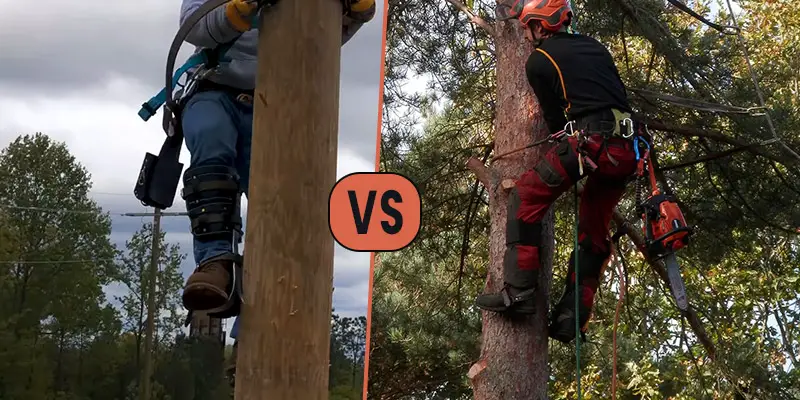Lineman Boots vs Logger Boots are uniquely designed with exceptional characteristics that protect those working in the logging industry and those working on electric poles.
These outstanding features separate them from other shoes such as working and hiking boots. Logger boots are tailored for people working in the logging industry while lineman boots are fashioned for electric technicians and workers who deal with tree services.
Although logger vs lineman boots have common features that make them look similar, they have precise distinguishing characteristics that make them suitable for different purposes.
5 Distinguishing Features Lineman Boots vs Logger Boots
Is there any difference between Lineman Boots vs Logger Boots? Read on to find precise answers to this question.

1. Heel Size Differences
Logger boots are designed with higher heels than lineman boots. The larger heels are suitable for walking on wet logs without slipping. The larger heels also help you walk on top of forest debris with maximum foot comfort. On top of that, the large heels help you maneuver the rugged forest terrain with ease.
On the other hand, lineman boots are designed with slightly smaller heels because they are mainly used for climbing poles, an activity which does not require large heels.
2. Steel Side Plates
Lineman Climbing boots are designed with sturdy steel side plates to protect the shoes from damage while climbing trees and electric poles. The steel plates minimize friction between the shoes and poles protecting them from mechanical wear and tear. Additionally, the steel side plates are used to ensure that a firmer grip is achieved between the lineman boots and the climbing irons.
However, logger boots lack steel plates because they are mainly used on the ground.
3. Weight of the Boots
Lineman boots are heavier than logging boots with spikes. Linemen spend most of their time on wooden electricity poles or steel electric towers. As a result, they are designed with heavyweight and more robust materials. On the contrary, loggers spend most of their time on the ground.
For this purpose, their boots are designed with lightweight and sturdy materials to protect their feet and ankles from friction, abrasion, and hard impacts from falling logs.
4. The Flexibility of the Soles
Logger boots have more flexible soles than lineman boots. Lineman boots are designed with rigid soles to prevent the shoes from flexing and twisting when climbing an electric pole or a ladder. On the contrary, lightweight logger boots are designed with flexible but sturdy soles to enable you to walk comfortably while at the same time provide mechanical protection to your feet.
5. Width of Boots
Lineman boots are crafted with slightly wider interiors than the standard logger boots. The somewhat broader interiors ensure that your weight is distributed evenly across the soles of the shoes. The uniform weight distribution ensures that there are fewer pressure points across the boots, a property that provides maximum stability while climbing and working on tall poles.
Likewise, your weight will be more spread out in such shoes, enhancing your overall balance. Logger boots, on the other hand, are not equipped with this feature because they are mostly used on the ground where stability is not as crucial as that on poles.

Verdict
To summarize, understanding the critical differences between Lineman Boots vs Logger Boots is essential at ensuring that you appreciate the unique applications of these shoes.
Furthermore, the distinguishing features are essential at helping you select the appropriate type of boots for a particular task. I think anyone distinguishing the difference between the logger and climbing boots. It will help to choose the best one boots.
